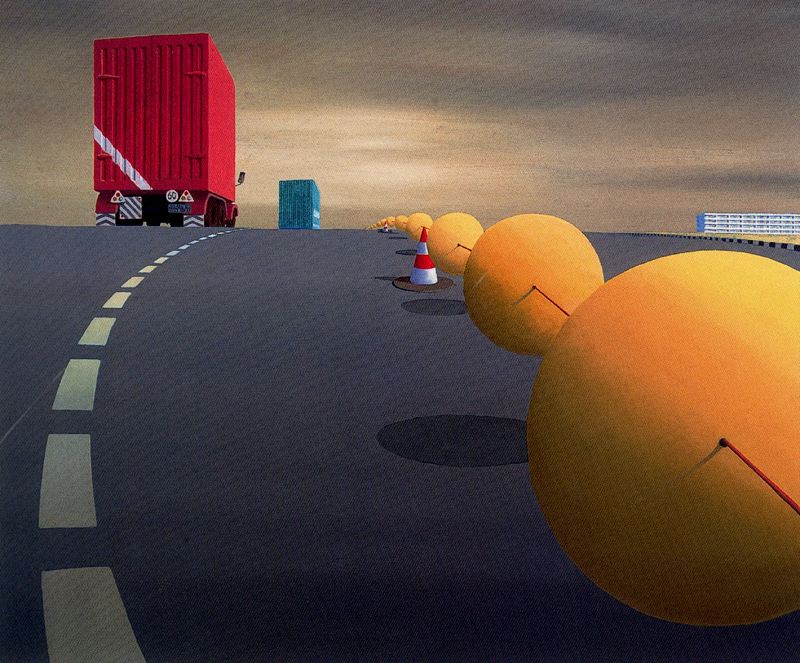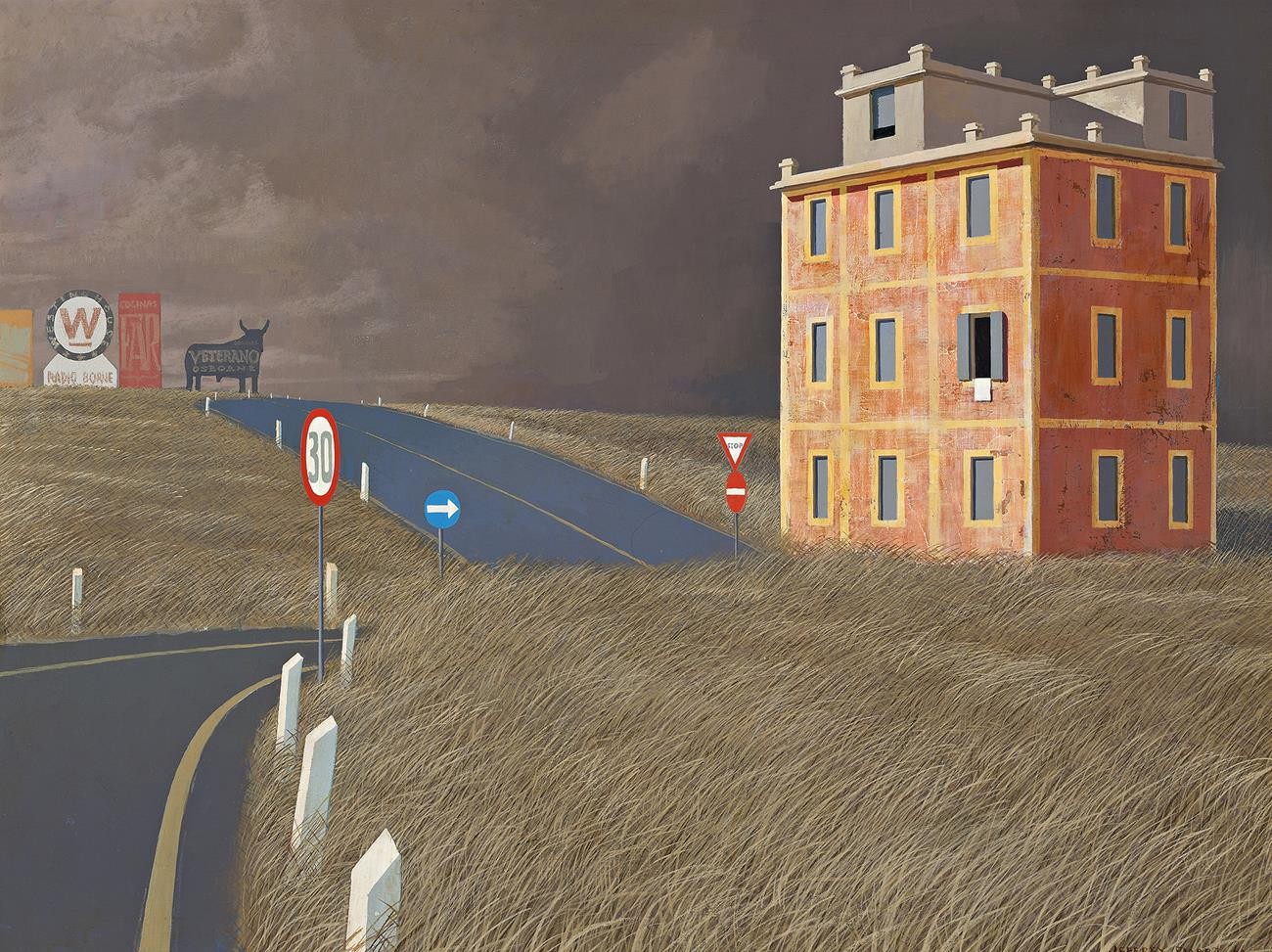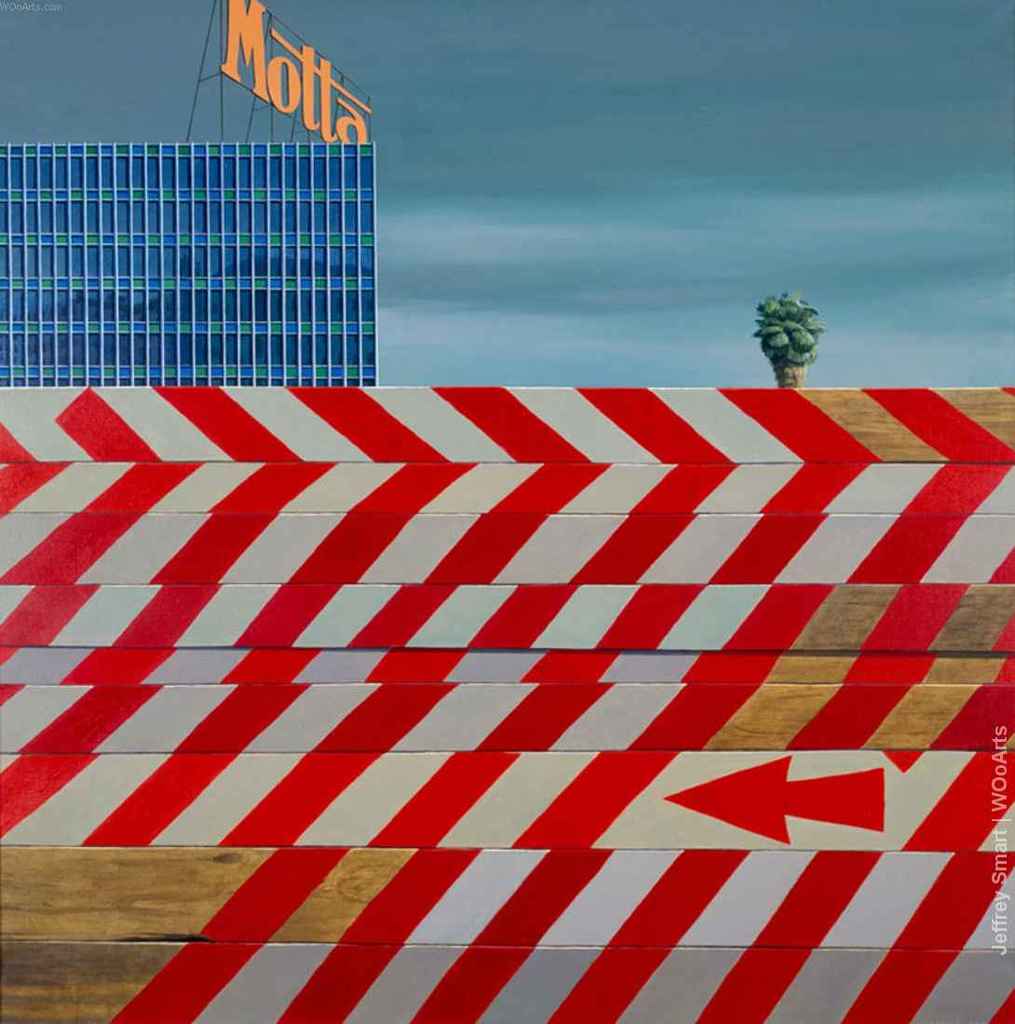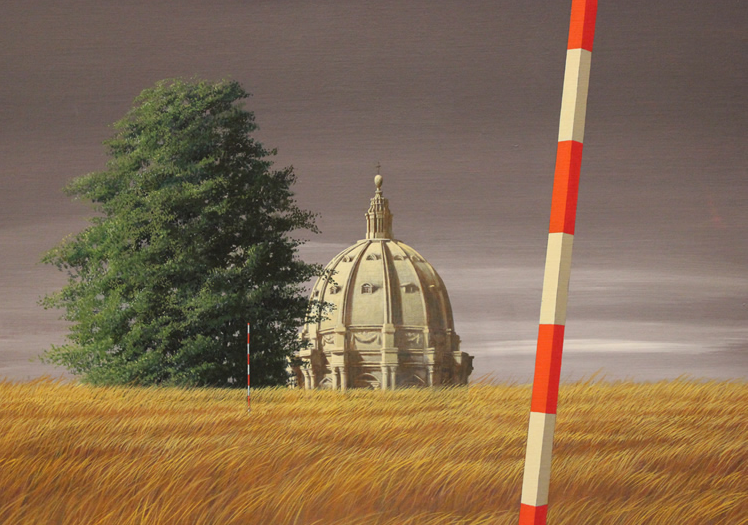Five Jeffrey Smart's Paintings
Guiding Spheres 11 (Homage to Cezanne) 1979
Fiumicino Bypass, 1966
The Red Arrow II, 1973
The Dome, 1977
Realism or Surrealism?
In each of these five paintings, every singe object could have been photographed and would have looked very much the same. Every object is simple and realistic, and every scene is outdoor. This is one reason they look typically Jeffrey Smart and the reason why he is classified as a painter of realistic landscapes. There are roads with a painted sign and the back side of two trucks in the primary colours red and blu. There’s a lonely house on a field and traffic signs, there are fields of dry grass where every straw is painted. The contents of the Farmhouse are not strictly typical Jeffrey Smart except the oil drums in the primary colours red, blu and yellow. Both the road sign arrows and a stick are painted in the artist’s favourite sugar-cane red and white stripes, realistic and typical Jeffrey Smart.
(press on a picture and you get a bigger version of the painting)
Surrealism is often characterized by objects that are somehow disformed or don’t look as we usually see them, like Salvador Dali’s watch floating as if it were made of a liquid or things in the painting were combined that would never fit together, like and elderly nobelwoman in bed with a huge durty boar or a five year old decapitating his mother or faeces coming out of the anus of a Norwegean Woman pained by N??????. Anything that could never happpen in real life but on a painter’s canvas. Jeffrey Smart never paints a surrealistic object. Still, he creates an atmosphere many experience as not quite real.
We know that roads don’t look like this, there is traffic, there are people, the road ground is more uneven or differently coloured due to traffic. This is a stylized road, where the cone and the spheres suggests work is being done, of which there is no sign, iit all looks perfect and not like a road being built or tranformed, and the distand building block looks more like a piece of lego than a home for hundreds of people. So, the ‘home’ was a piece of lego more than a home for human beings.
The guiding spheres suggest some work is being done to the road, we see nothing of this. It looks more like an abandoned road, or a road in construction where there should realistically be no trucks. The building blook in the distance is not realistic place alone on a field, nothing surrounding it. The juxtaposition of these things appears as not quite real.
the building in Fiumicino Bypass may appear spooky, scarcely comfortable to visit alone or a stage set, where the ‘building’ is a set made of wood and cardboard and the white linnen hanging out of the window put there theatrically by a stage manager creating an arti farty set.
surrealistic in the way things are put together. There are no cars or travellers on Jeffrey Smart’s roads and no animals around the farmhouse. Blankness and lack of people contributes to a spooky atmosphere. And who puts the bright coloured oil drums in the primary colours red, blue and yellow in the foreground. Not a farmer, but Jeffrey Smart and we find them all three in another picture. As beautiful as portrayed, we wouldn’t visit this farmhouse alone. And as much as we understand the farmhouse is real, we know the artist has modified its shapes and colours to serve his purposes to induce emotions of wonder or unease but still make us captured by beauty and admiration.
But here’s also something hidden. Jeff doesn’t pay without without being cunny, witty some would say. There is something oddish in the perfection the artists tries to achieve which creates tension. Real but still not real. Our perception becomes equivocal. Despite only realistic objects in his paintings, they convey an atmosphere of unreal. There is a disproportion between the almost perfect geometric structure and the imperfection in putting trivial or uninteresting elements together. The house in the bypass is just too lonely to be “real” and the grass is too perfect to be “real” and the traffic signs in the distance seem to have no relevance for the traffic, they are being objects for colour or position perfection, and their presence in this place is not “realistic” like putting a gorilla as ‘best man’ at a wedding cermony.
In essence, the objects in the paintings are all real and painted well enough to look real, but there is something odd about assembling them. They are not assembled to give a ‘real’ picture but to convey a distorted reality, as in a dream or perceived by a brain affected by drugs.
Jeffry Smart’s treatment of illumination is always particular. While the skies are usually dark, sometimes black, still a bright light in the foreground makes sharp shadows. The artist puts a powerful source of light somewhere when he needs it but we never see it and sometimes it is even difficult to imagine where the strong light arrives from or the light that is directed towards a single object under a black sky. The juxtaposition of a dark sky and brightly lit objects creates a spooky atmosphere which the artist repeatedly utilizes. And a large shadow covers part of the painting but one cannot see what makes the shadow. The shadow is there, not to be ‘real’ but becuse of the artist’s motive to created an effect that we are not aware of.
Cubism?
Cubism as a term signifies
The geometric structure of the paintings and the harmonious balance between parts can be seen as the common denominator of these five paintings and as the artist’s major hallmark.
A closer analysis may cut up each painting into well-known geometric shapes. The sky appears as a rectangle, as do the red and blue trucks. The distances between parts, often the Golden Ratio, is known to be pleasant for the human mind, in a smilar way as keys in music are pleasant for the ear. Notice the cheeky little flowerpot or palmtree(?), exactly on the golden mean of the distance between the right canvas edge and the blue building in Red Arrows.
Within twenty-four hours of our first meeting, Jeff explained to me the golden ratio. He said a sample of naïve individuals, when asked to put a flowerpot on a mantlepiece to make it look attractive, would put it at an average at the golden mean. So, watching these paintings should give a pleasure like watching a face where nature was generous enough to make distances in the face adhere to geometric rules. A kind of cubism where you don’t notice the cubes. The viewer experiences the effect ignorant of its causes.
The arrows are candy-cane-coloured, a favourite colour combination which pops up in many of Jeff’s paintings. They show which way to go. But the single little Red Arrow shouts, Go the other way, go your own way! when every other sign shows the opposite. Jeff was far from a conformist, neither in his life nor in his art.
Since geometri and espcially the Golden Mean had a central place in Dr Smart's work I will give more details in a couple of paintings below. To the left is a painting from 1971?, Morning Exercoces, Baia, 1969. There is an interesting analysis of the geometri and the historical background of the work. Another work of a similar fame and importance in Jeff's carrear is the work from 1963, Cahill Expressway.
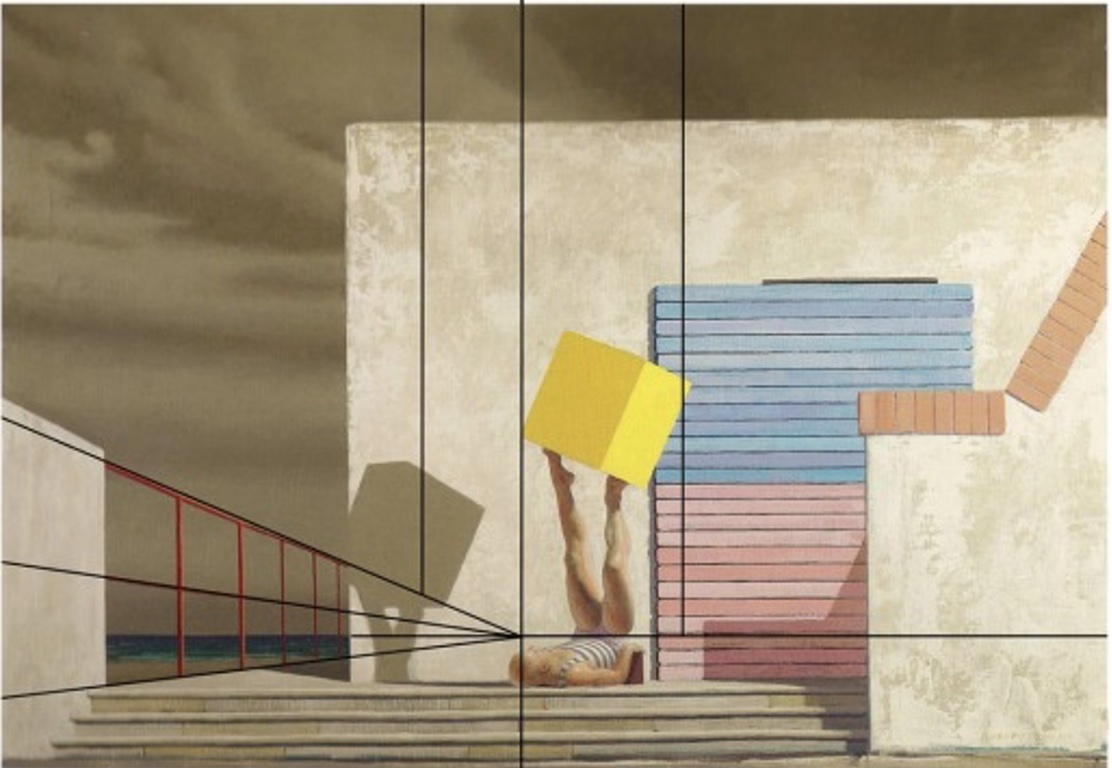
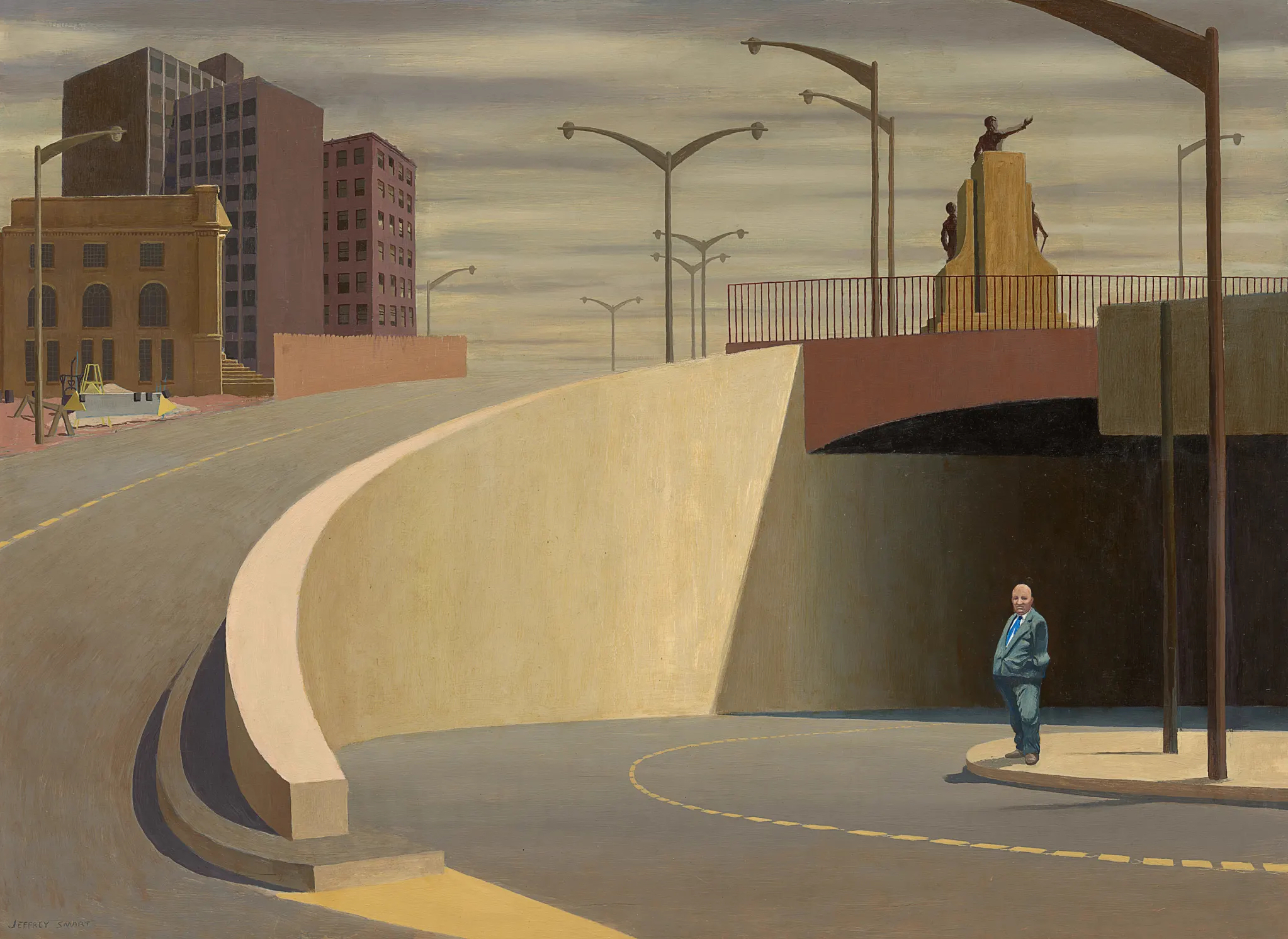
A closer analysis may cut up each painting into well-known geometric shapes. The sky appears as a rectangle, as do the red and blue trucks. The distances between parts, often the Golden Ratio, is known to be pleasant for the human mind, in a smilar way as keys in music are pleasant for the ear. Notice the cheeky little flowerpot or palmtree(?), exactly on the golden mean of the distance between the right canvas edge and the blue building in Red Arrows.
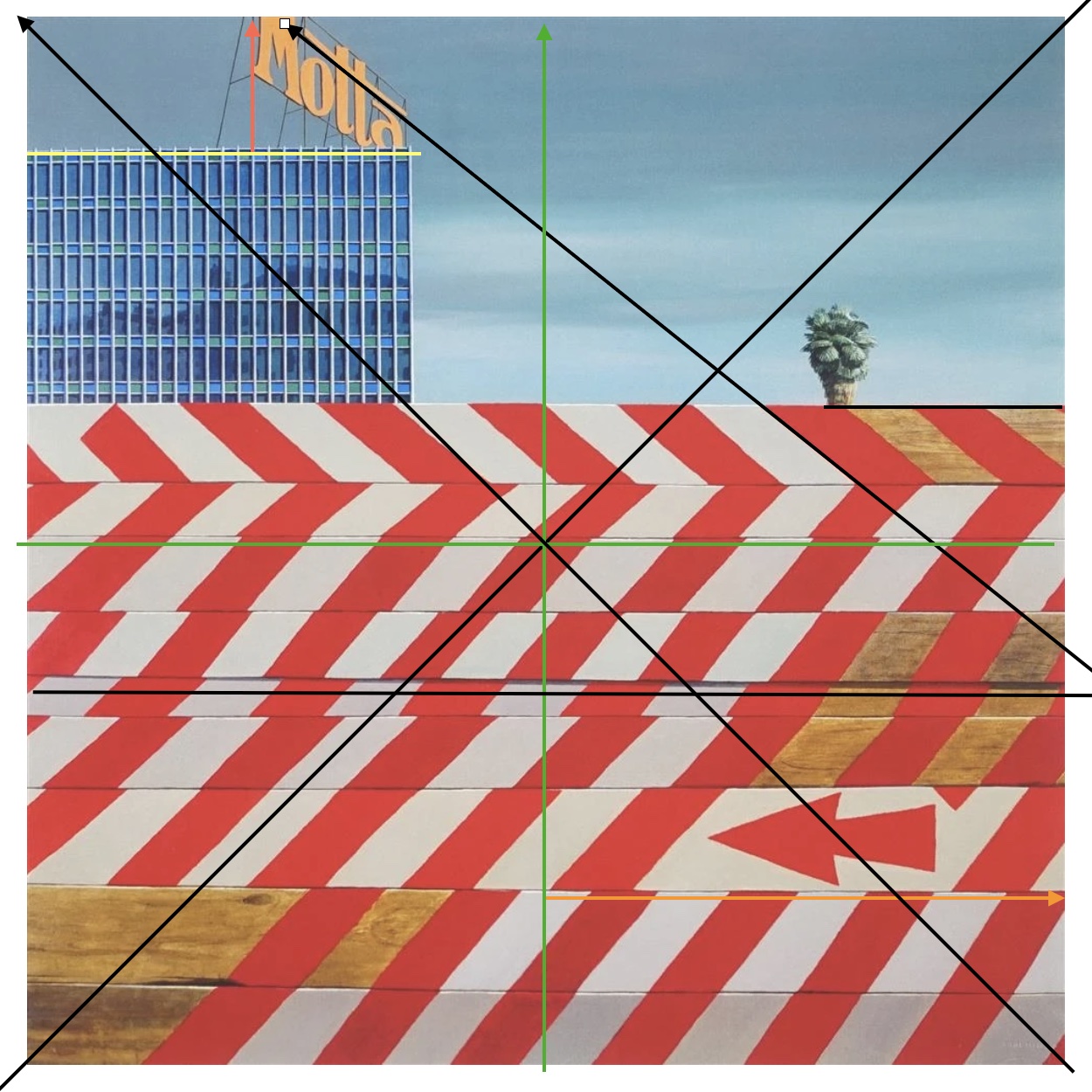
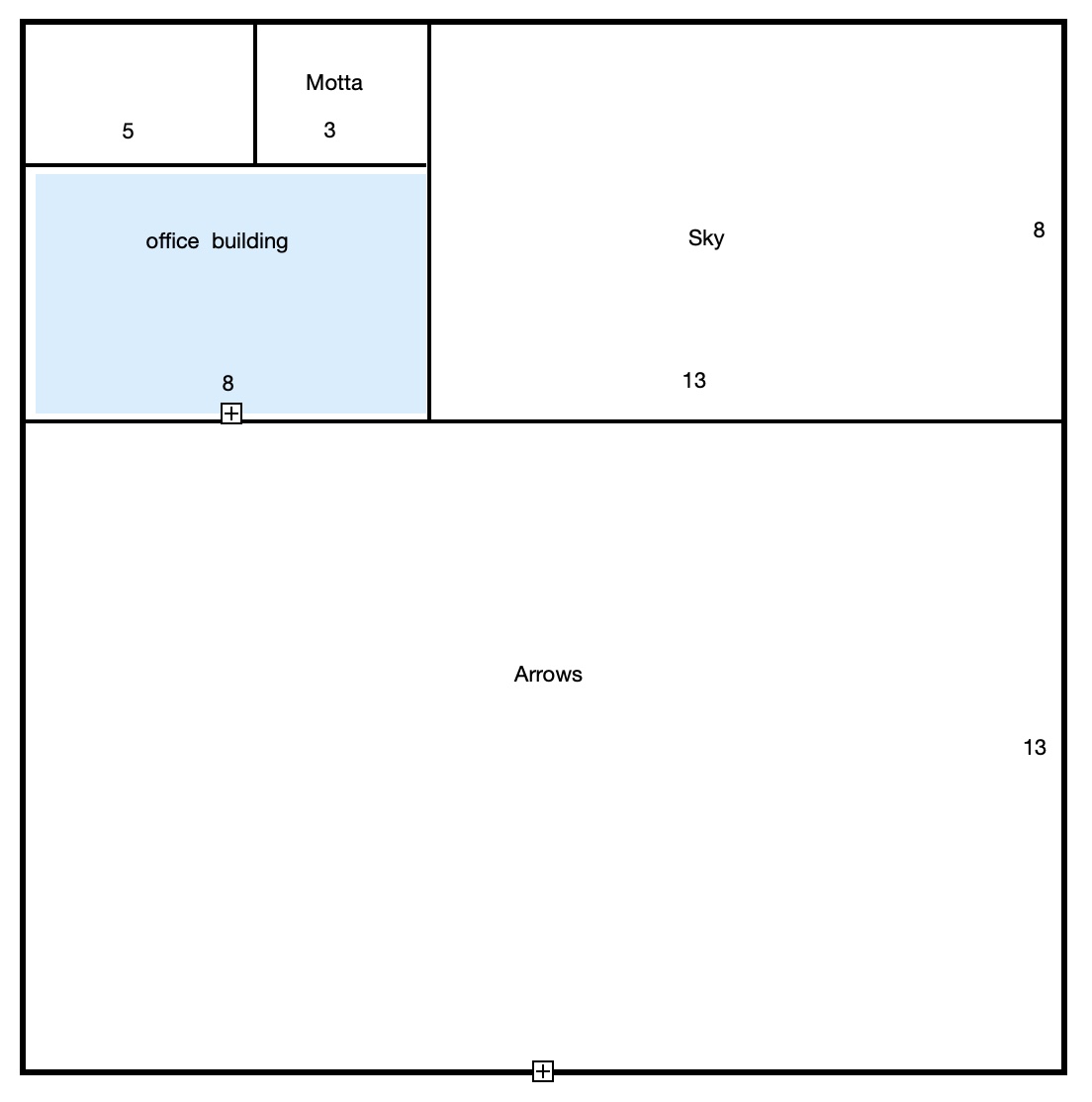
To the left you see lines I have put in Red Arrows and which shows the utmost care Jeffrey Smart has given to directions in this paingin with lines in both directions. First, the green lines show the middle of the painting both horisontally and vertically. Horisontallly this is where the second and the third lines of red/white arrows are separated. Horiisontally the golden mean from the bottom separates the arrows from the bilding and the sky. Then there are two major parallel lines,, one is from the line in the Motta ad which has the same angle as the arrows pointing in that direction. The other direction of the arrows is parallell with the opposite diagonal. Since the whole paintinng is a square both diagonals meet in the centre of the painting, where the two green lines meet. So there is a perfect balance in that all that leans leans in the same direction of in 90 degrees, and all lean in 45 degrees to the horisontal line.
To the right the paintings devided into the varias major arreas that are delineated by distances of the Golden Ratio, whicvh is about 1:1,6. For all major distances I have put the width and the hight to 21, and hence devided by the Golden Ratio into 13 and 8. Then the upper part of the painting is divided by the building which is 8 broad, and at the top of the buiding the Motta ad devides the 8 into 3 for the ad. So we get a lot of equations where 21 should be to 13 as 13 is to 8, which should be the same as 8 is to 5 and 5 is to 3. And a simple calculation shows that 21/13=1,62 13/8=1,63 8/5=1,60 and5/3=1,66. Almost perfect.
The geometry of this painting has been exceptionally easy to see. In most cases the various areas created by the Golden Ratio distace are more subtle and hidden. A lot of reseach has been conducted to find the distance and the angles common inbeautiful faces and in bodies of pleasant harmonial structure.
I was sure the palm three wouls be found at the Golden Mean, and maybe it was intended to be there, but the pot(?) would have had to move half its size closer to the buildong to have its centre exactly on the Golden Mean.
EMOTIONS AND OPINIONS ?
Perception
Dr Jeffrey smart demonstrates the relativity of perception – which one could call a philosophical opinion. How you see something is a personal matter and depending on internal matters, your mind and the second of perception and all aspects of the circumstance.
There is never a true perception of anything except your own personalvery fluid and occasional and passing disposition to perceive. The way Jeffrey Smart catches such a passing millisecond and makes it eternal gives you a concrete sign of relativity, and specify how such a millisecond could look, and only now and would never ever look again nor for him nor for anybody else. He shows one of an infinite number of ways to perceive this view. And the question arises, what is real? It’s just a personal choice. And each such choice can be regarded as “true reality”.
This is a general philosophical statement Jeff makes. His art forces you to reconcile your own reality and see how fluid and temporary it always must be. There is no other realism.
A View of the World
To the far right, Jeffrey Smart’s invites us to his mighty exposition of the major composites of our world. In the centre we see the head of the institution which has ruled and tortured our societies for fifteen hundred years.
Beside the mighty dome the green natur with its own demands for world domination is taler and broader and look healthier . From the studies Jeffrey generously have offered we know that originally there were only the dome and the tree. We have also heard Jeff reason about his old painting Holiday resort, where it took some time before he realized the pram would make the picture complete. It may take weeks before he finds the final soltion to a painting. In this case he finaly put his personal favourite before both Nature and Culture the lust he gets from painting the white and red sugar cane strip in one painting after the other. From this we learn that Jeffrey Smart’s priorities have greater influence on what ends up in his painting than world wide ideoloties. As always, Jeff first cultivates his garden. “Get your priorities right.” Jeff was quick to give advice.
It is easy to say that one can see Bach in Jeff’s paintings, the same adherence to basic rules of their arts, the repetition of patterns but always a cheeky little instrument in the background making your day with its little bright-red nose or noise. See these five paintings as five movements in a suite for not only pleasure and amusement but for contemplating existence. Like Bach, the creation is about nothing particular, hence about everything, about life, as they show us life in general and nothing in particular; we enjoy their company. Jeff’s paintings of buildings are not about buildings, there are more instructive photographs or draw board creations. His paintings of road signs are not about road signs, they are metaphors, there are more complete pages with all road signs you may want to see. Jeff invites us to see them as revelations of ourselves, the same as Johann Sebastian, as a discrete Ecce Homo.

